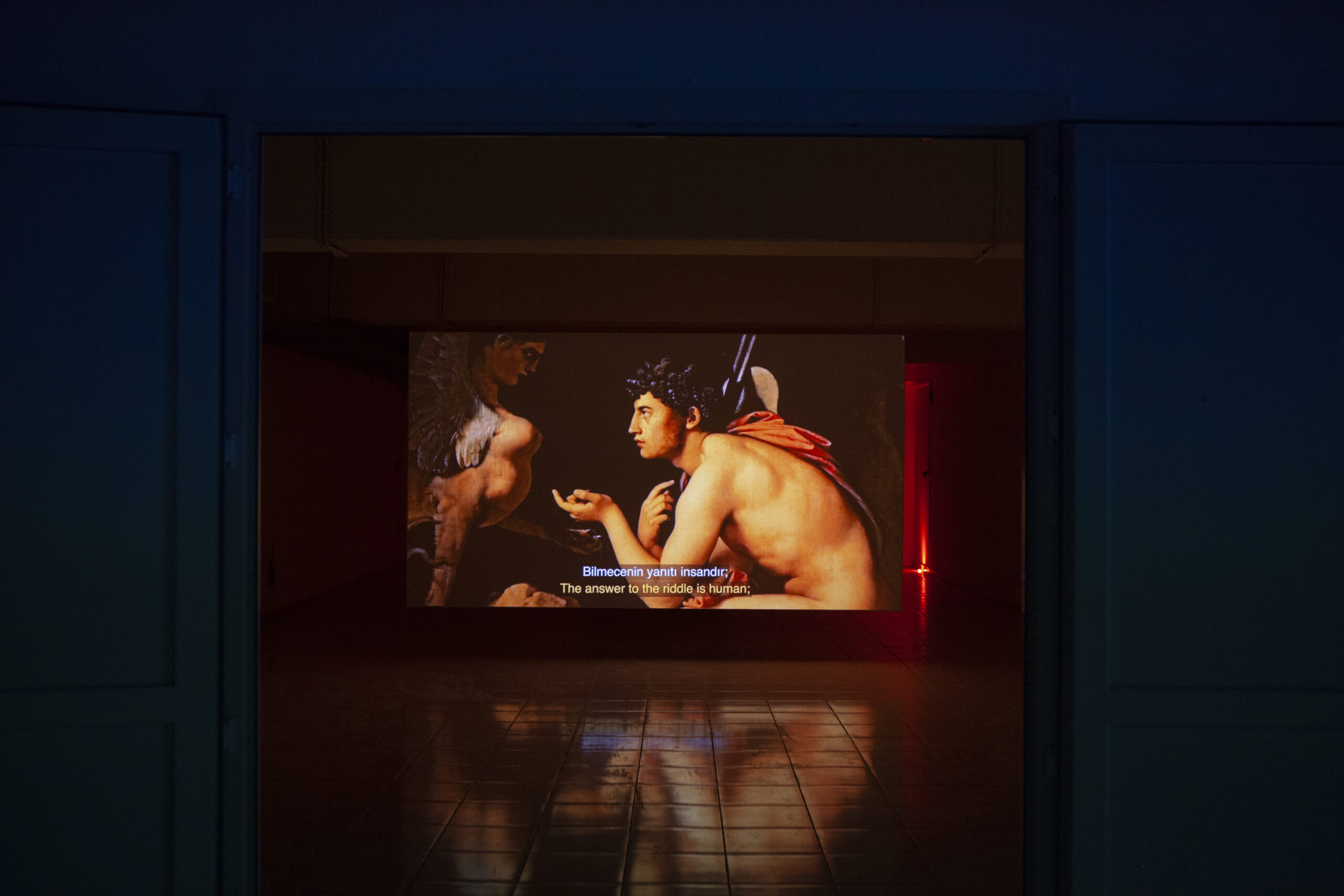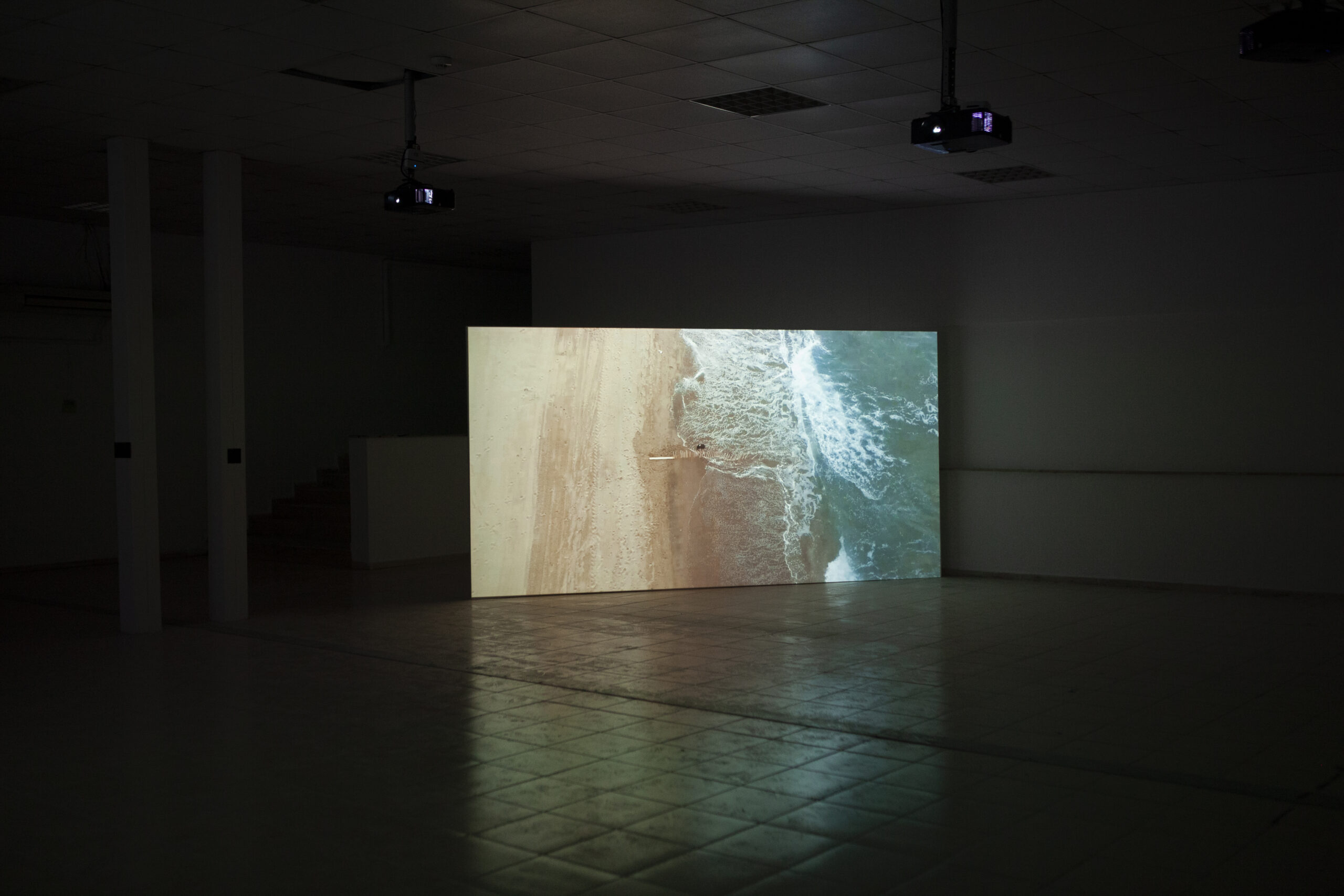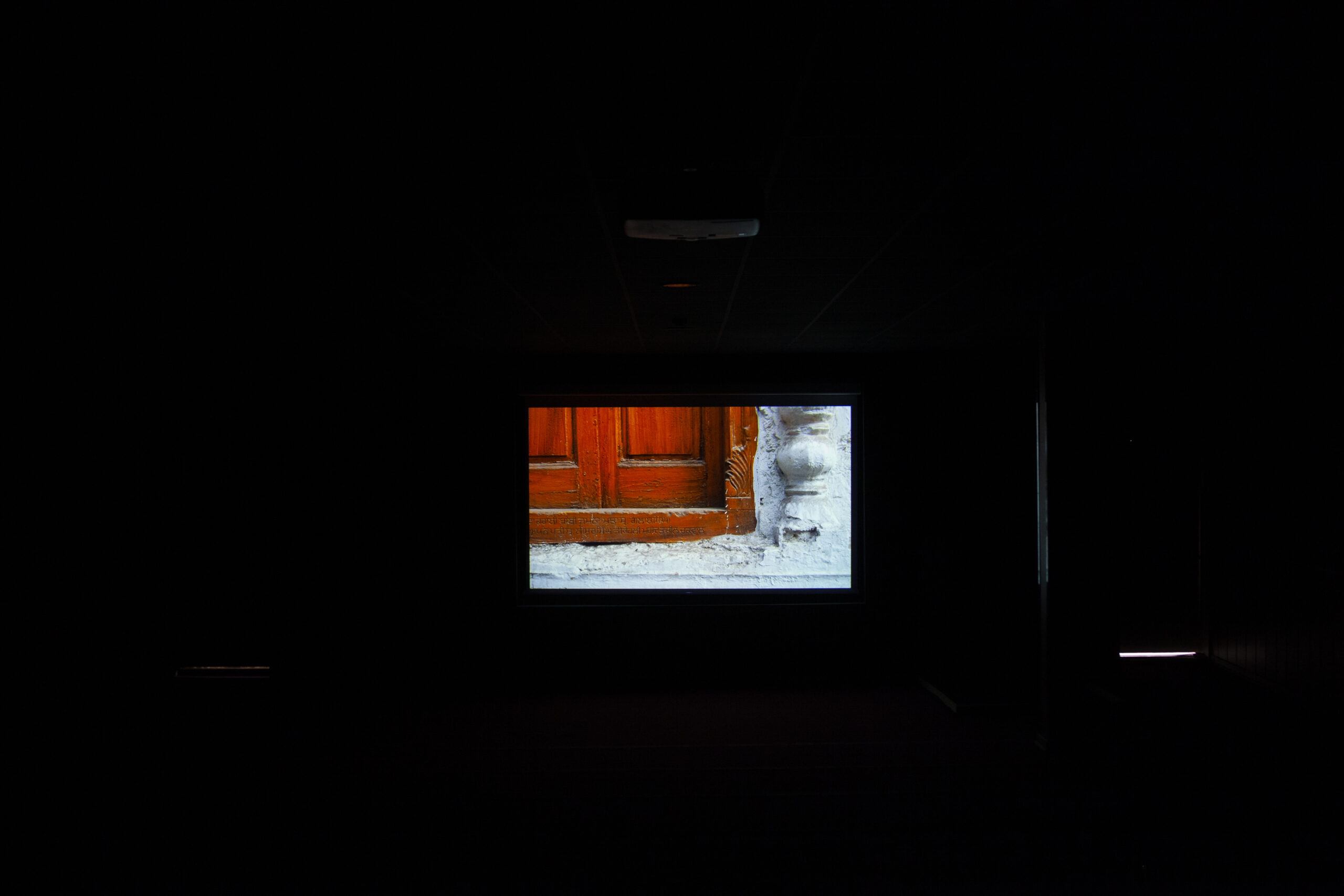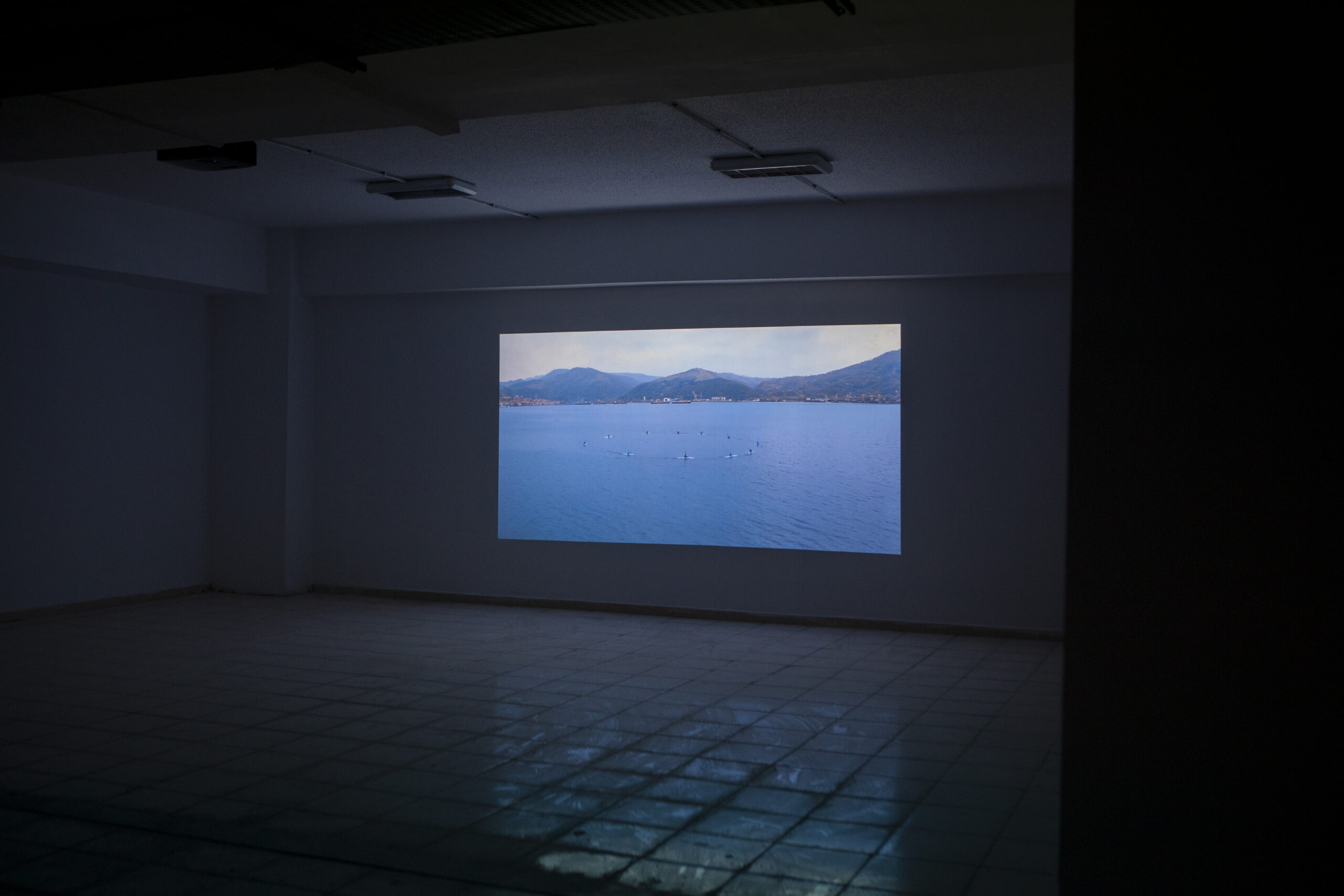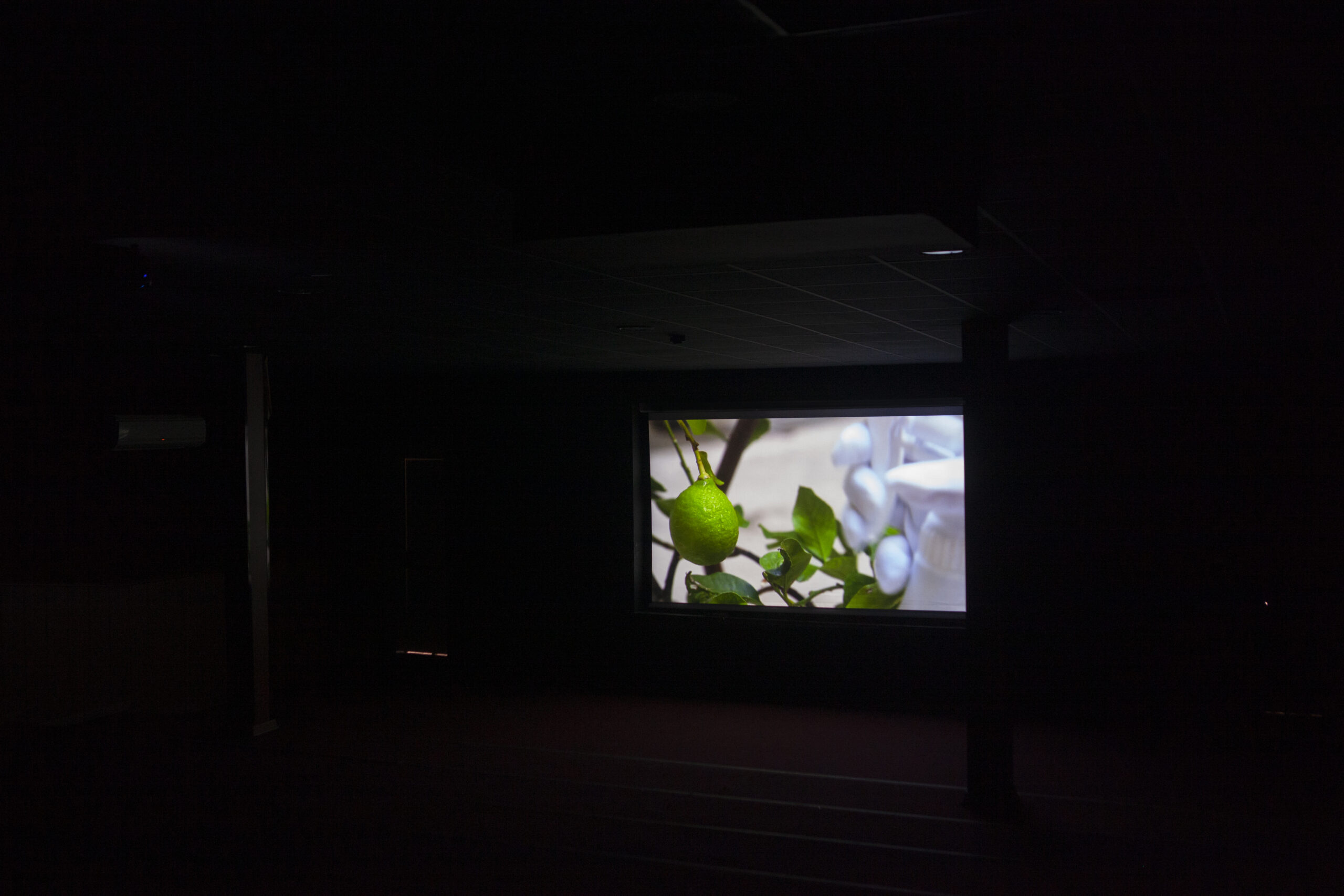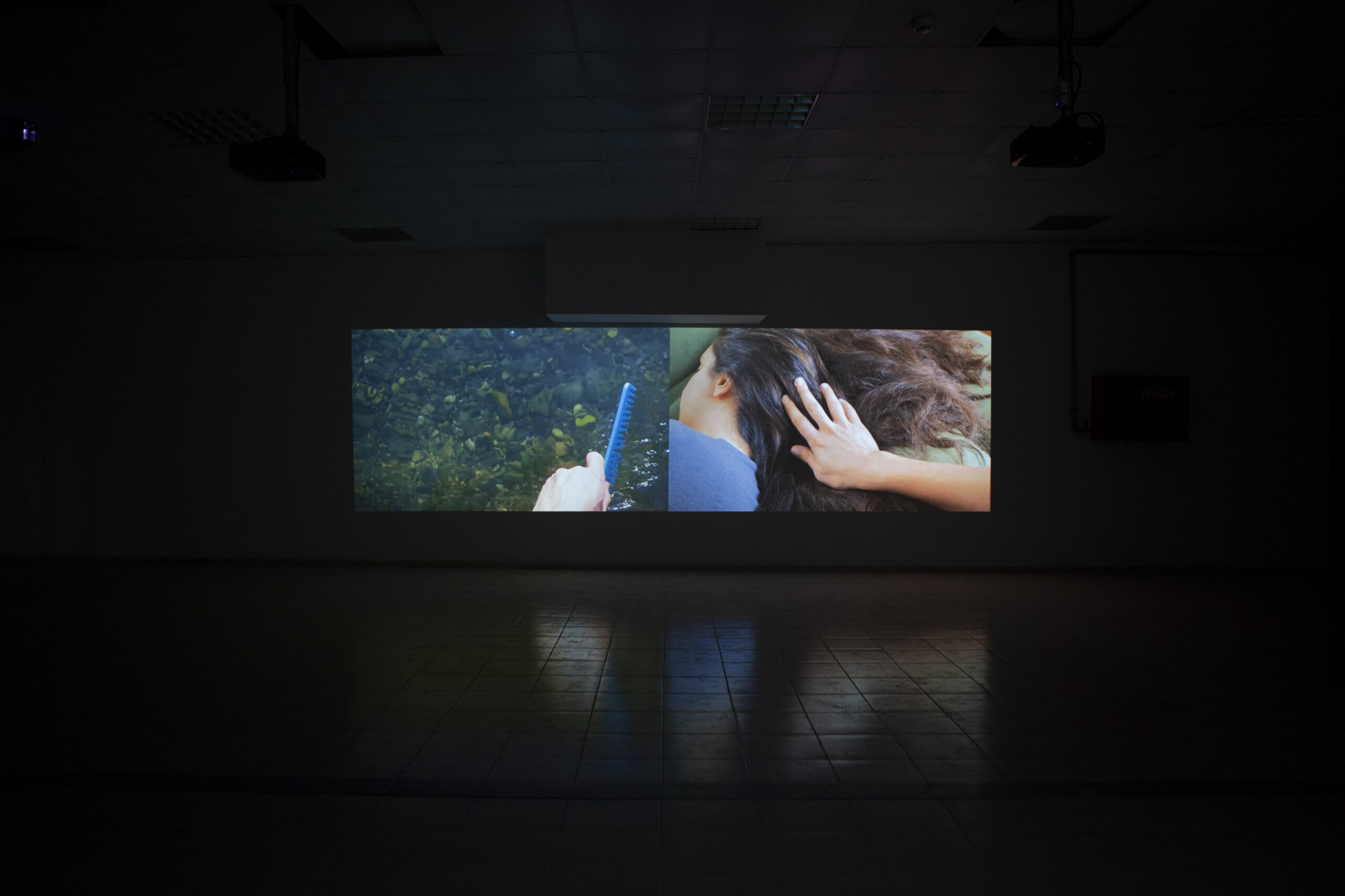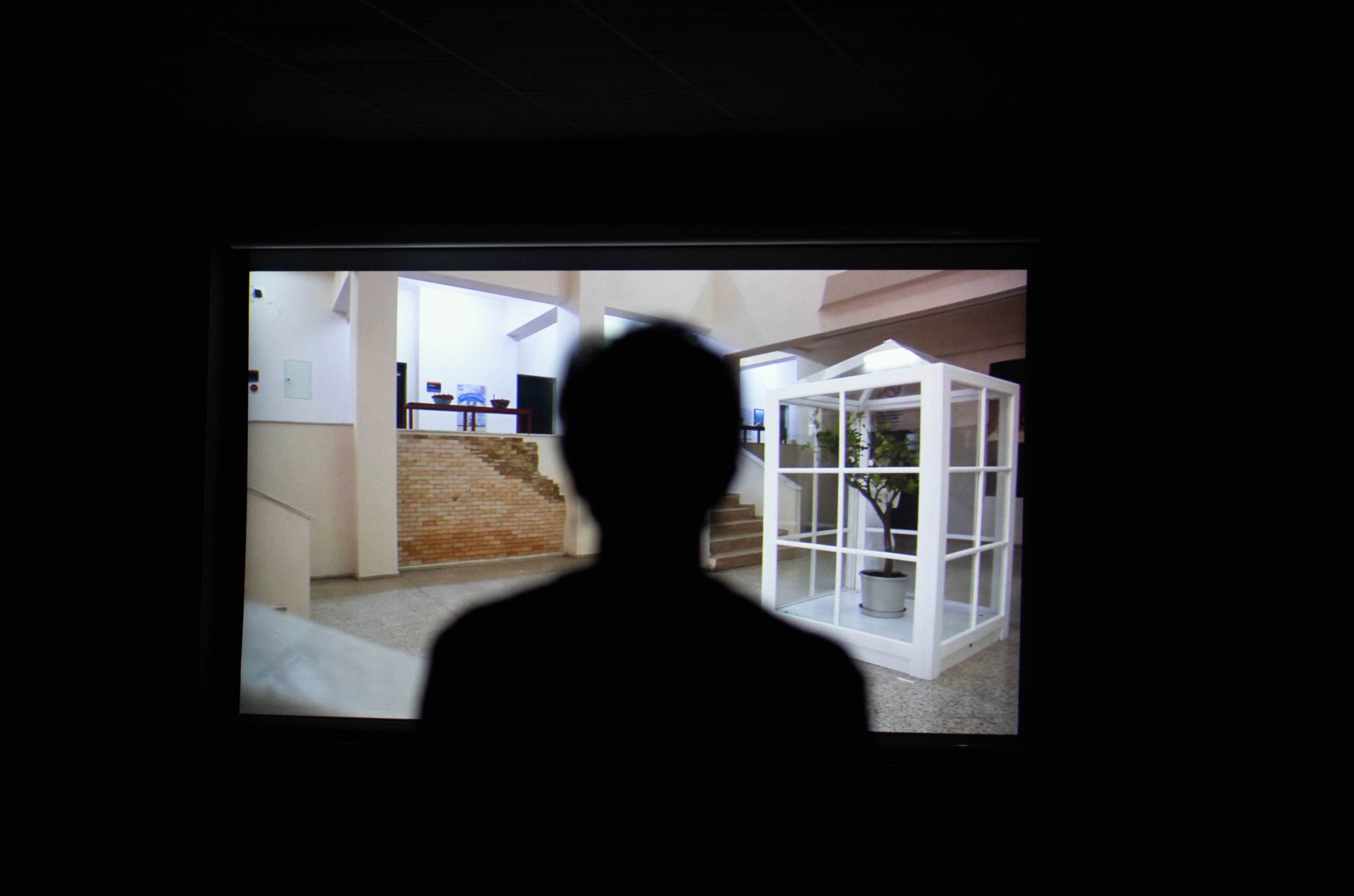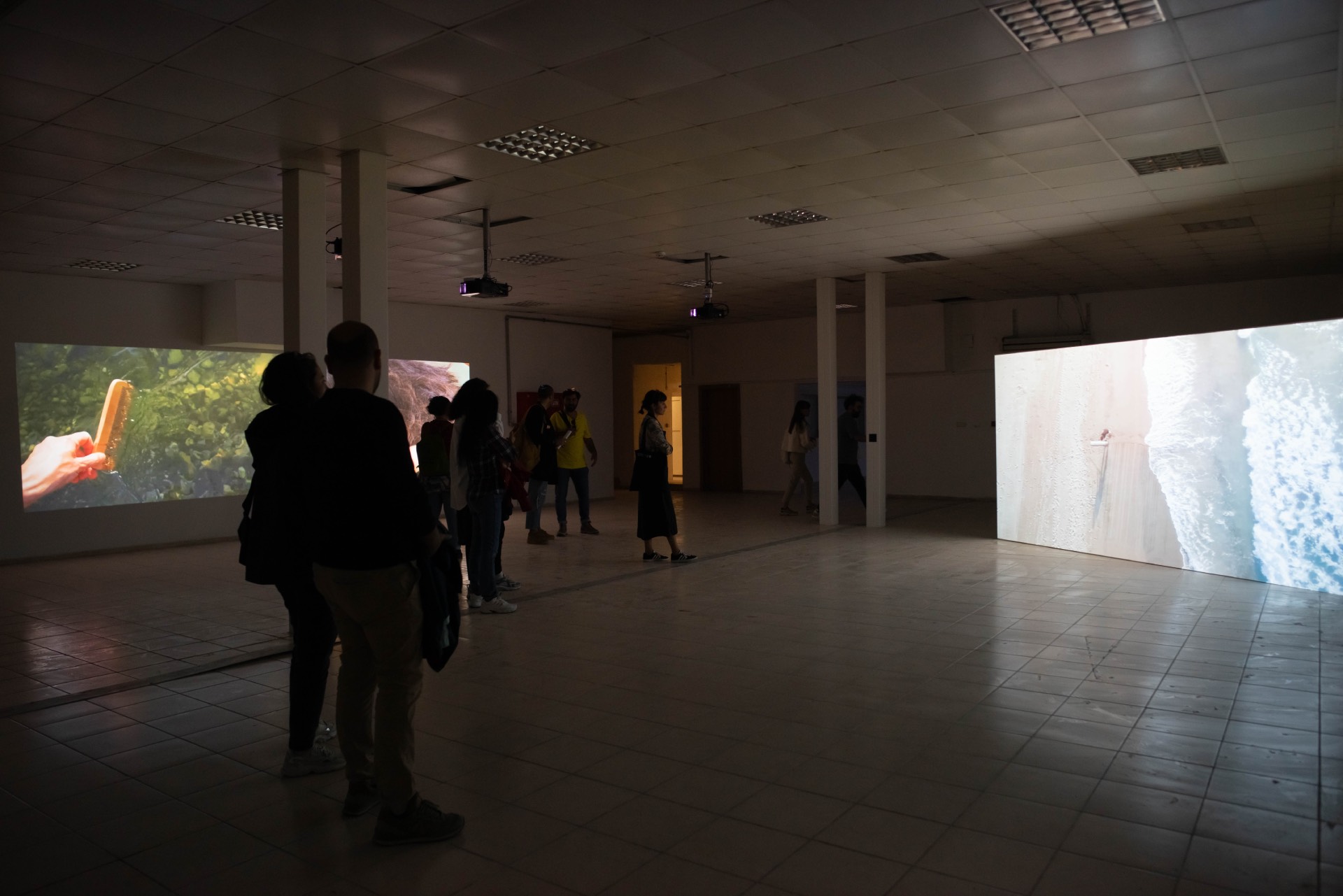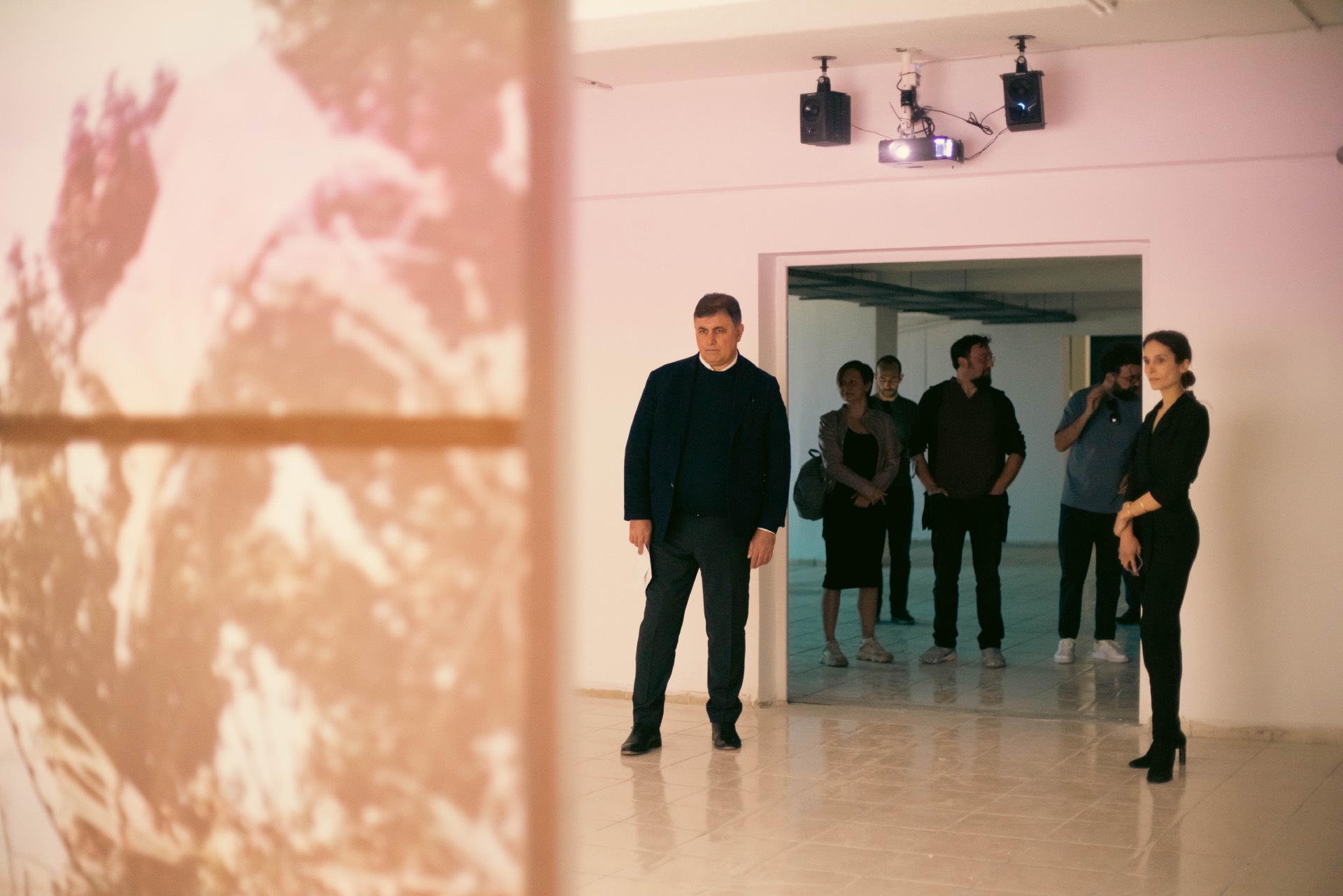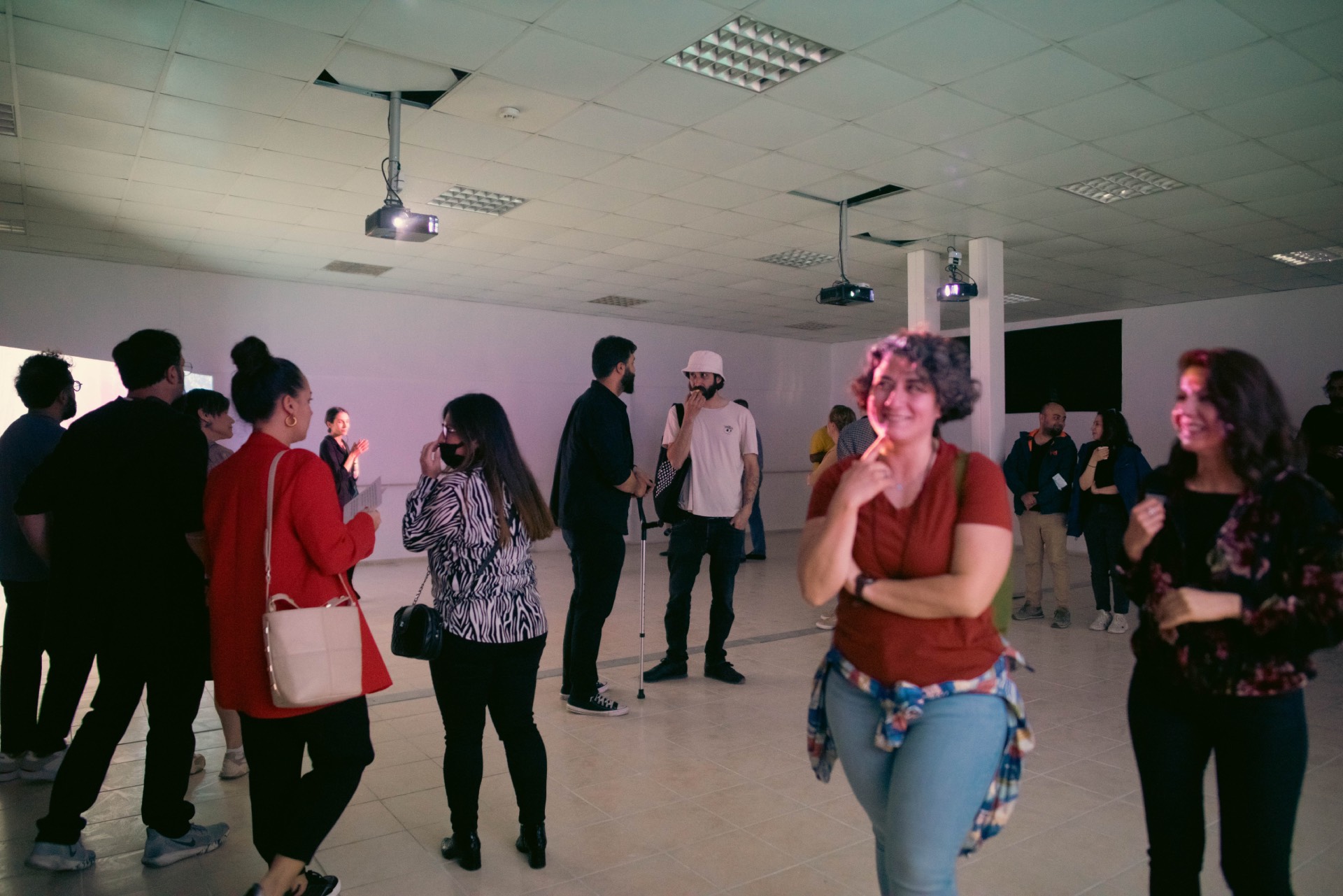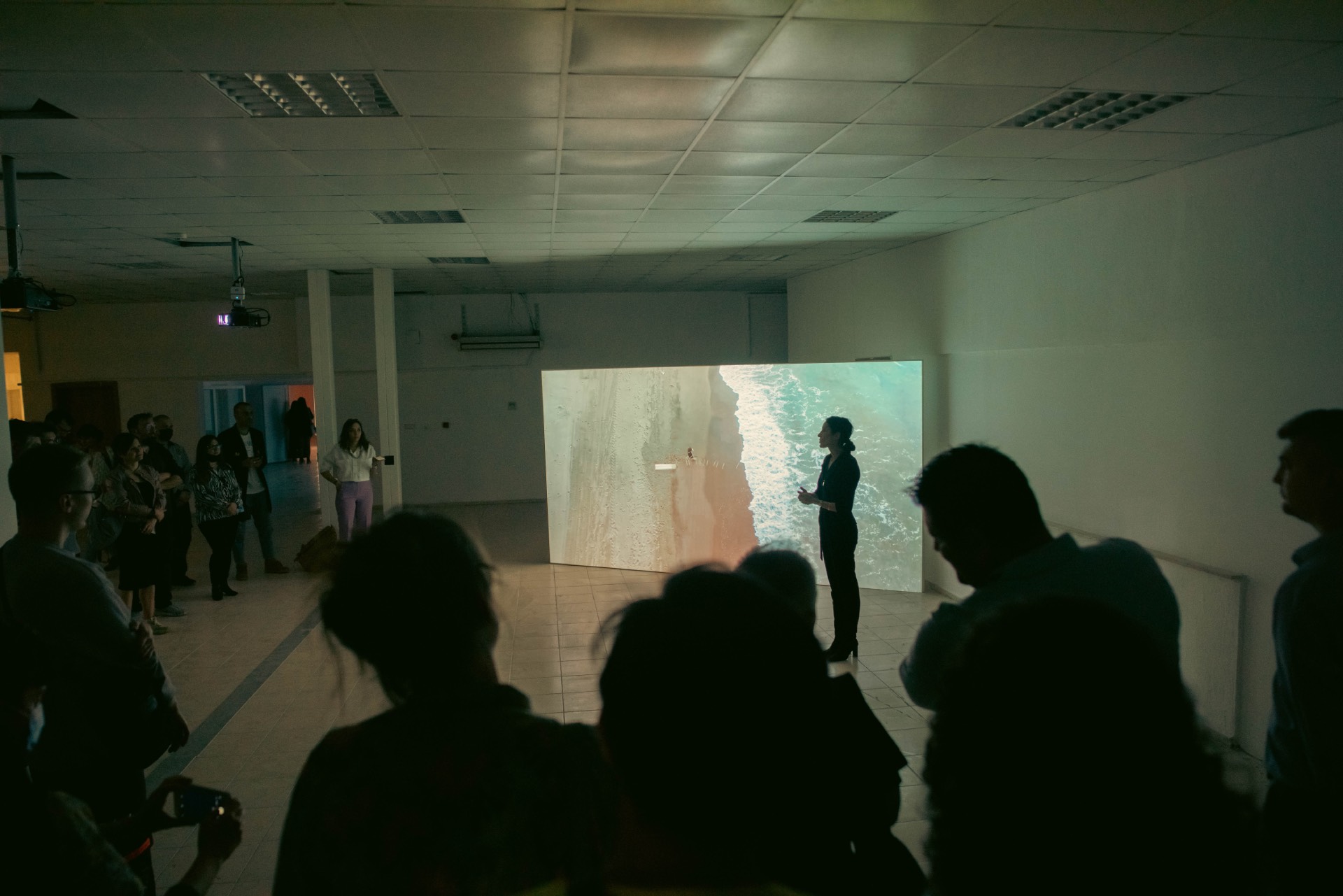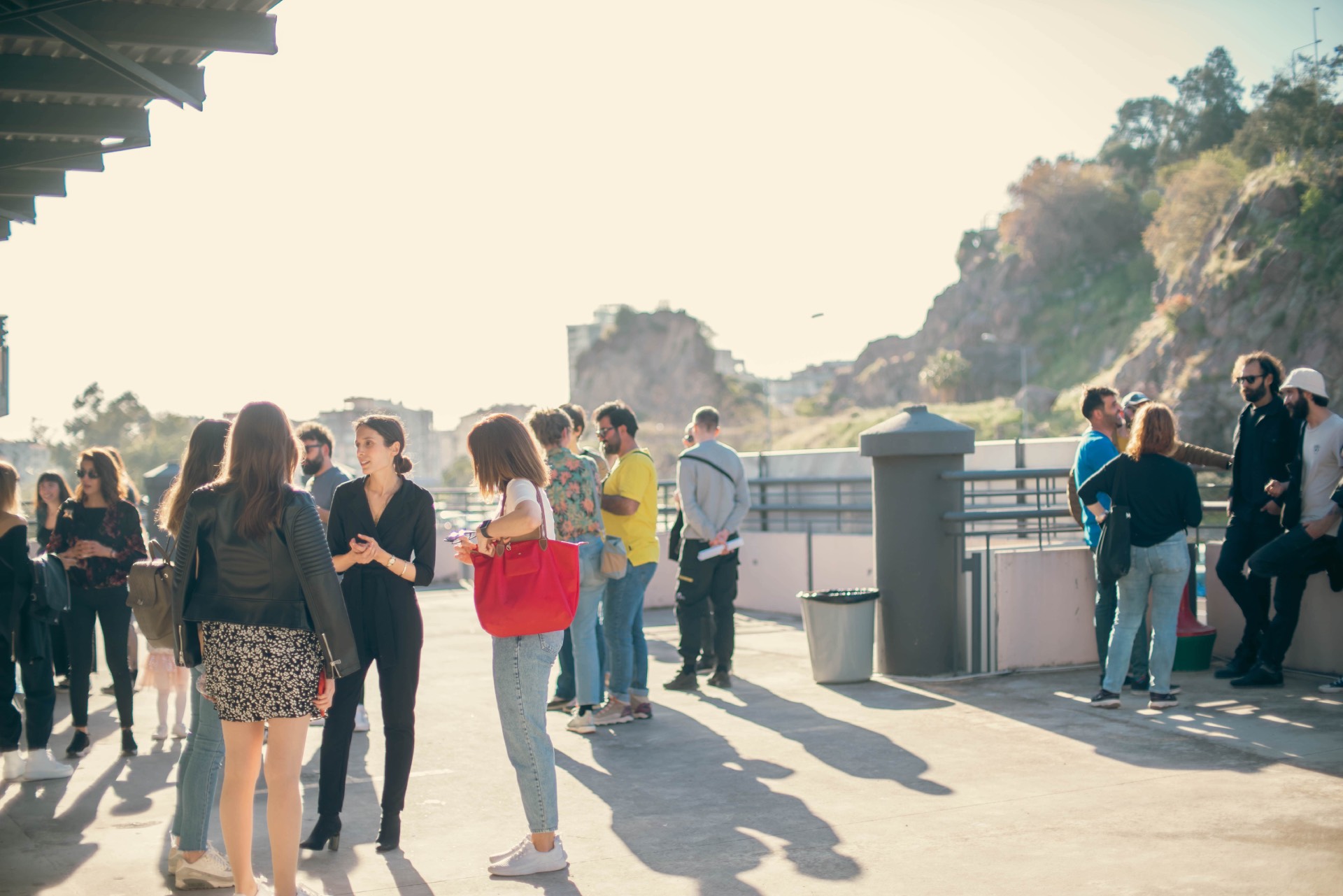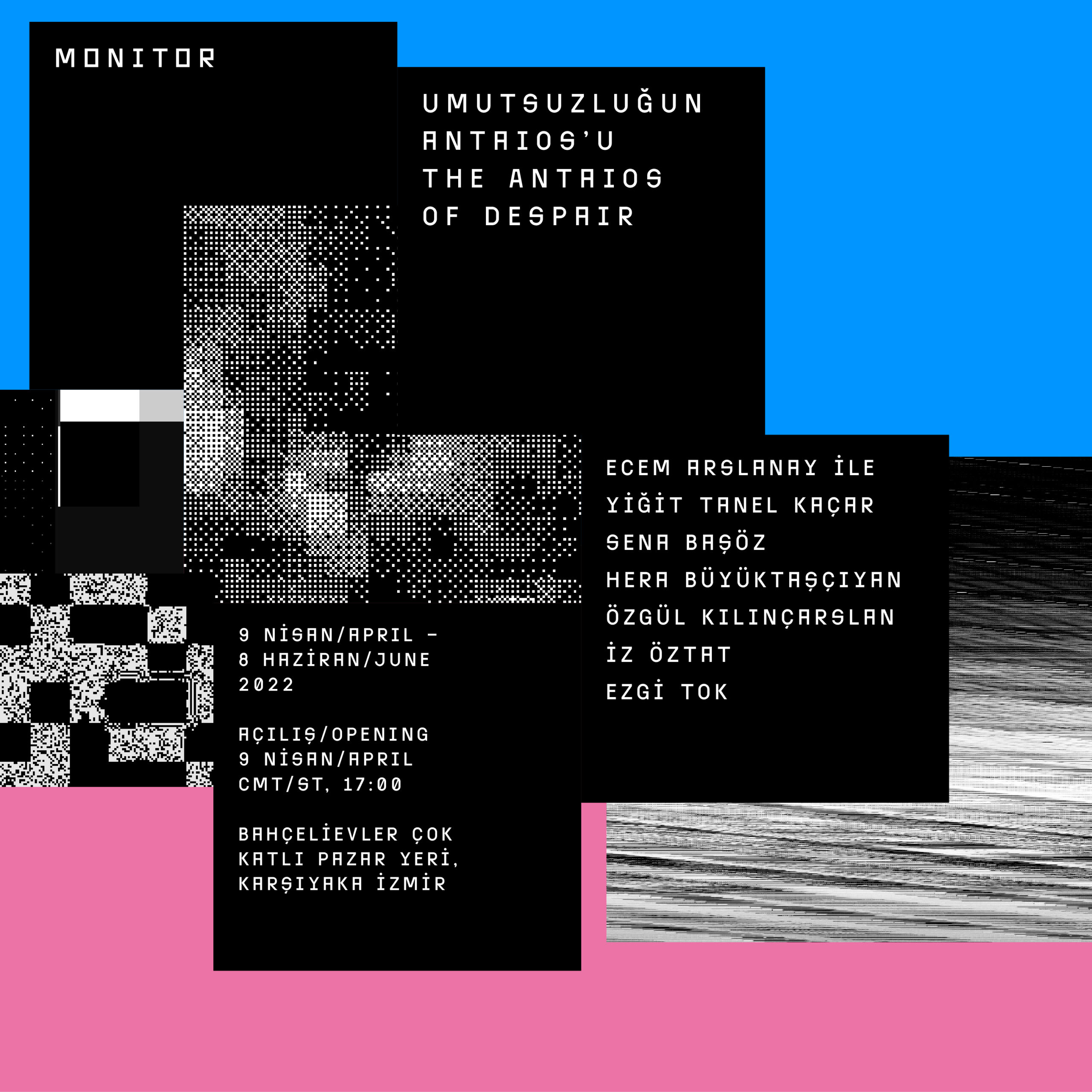Umutsuzluğun Antaios’u ⎮The Antaios of Despair
Umutsuzluğun Antaios’u*
Sanatçılar: Ecem Arslanay ile Yiğit Tanel Kaçar, Sena Başöz, Hera Büyüktaşçıyan, Özgül Kılınçarslan, İz Öztat ve Ezgi Tok
Bahçelievler Çok Katlı Pazar Yeri, Karşıyaka
9 Nisan – 8 Haziran 2022
Monitor son iki yıldır çevrimiçi yürüttüğü programının ardından “Umutsuzluğun Antaios’u” başlığını taşıyan sergisiyle fiziksel mekâna geri dönüyor. Zaman birimi olarak doğanın akışını rehber kabul eden sergi, Ecem Arslanay ile Yiğit Tanel Kaçar, Sena Başöz, Hera Büyüktaşçıyan, Özgül Kılınçarslan, İz Öztat ve Ezgi Tok’un video çalışmalarını İzmir Karşıyaka’daki Bahçelievler Çok Katlı Pazar Yeri’nde bir araya getiriyor. Bir Avrupa Birliği projesi olan CultureCIVIC: Kültür Sanat Destek Programı tarafından finanse edilen ve Karşıyaka Belediyesi tarafından desteklenen proje, kütleçekimini yitiren dünyada anlama yeniden kavuşmak için yavaşlama hâlini odak nok- tasına taşıyor. 9 Nisan – 8 Haziran 2022 tarihleri arasında açık olacak sergi, bir dizi konuşma pro- gramına da ev sahipliği yapıyor. Sanatçı konuşmalarının yanı sıra, Umut Altıntaş, Monica Papi, Güher Gürcan Tan ile Tangör Tan ve birbuçuk Kolektif!ten Yasemin Ülgen kendi üretim ve araştırma pratikleri üzerinden yavaşlamayı ele alış biçimlerini paylaşacaklar.
Doğal akışına müdahale edilen her şey sapmaya uğruyor. Bu sapmanın tesiri, direkt ilişkili olduğuyla sınırlı kalmayıp canlı ve cansız tüm varlıklara dokunana dek yayılıyor. Emil Michel Cioran, yaşamı ölüm gerçeğini inkâr etmeden anlamaya çalıştığı “Var Olma Eğilimi”1 isimli kitabında insanın zamanla mücadelesini izler. Ve görür ki, kendini akışa teslim etmeyen, onda kaybolmayan ve zamanla yarış hâlinde olan insanın ortaya koyduğu görüntüde bir çaresizlik hâli bulunur. Ecem Arslanay ve Yiğit Tanel Kaçar’ın “Büyük Saat, Küçük Saat” isimli çalışması, Cioran’ın tasvir ettiği türdeki insan tutumunun başlangıç noktasına, yol açtığı ve açacağı evrelere dair bir anlatı sunar. Kısa ömrüne çeşitli hırslarla her şeyden daha fazlasını sığdırmaya çalışan insanın hızlanarak sergilediği yararsız çaba, mevcudiyetler üzerinde delikler açar. Arslanay ve Kaçar!a göre insan ancak altyapısında yapacağı dönüşümlerle içi boşaltılmış anlarla dolu dünyada yitirilen ritmi geri kazanabilir ve seyrine devam edebilir.
İz Öztat “Bir Ada Teşkil Etmek” isimli çalışmasını, kendisine on yılı aşkın süredir görünen Zişan (1894-1970) karakterinin bir hikâyesinden yola çıkarak üretir. Yapılan baraj nedeniyle yıllar önce sular altında kalan Adakale’nin, Tuna Nehri üzerindeki varlığının izlerini işaretleyen çalışma, sanki zamanın akşını tersine döndürebilecek bir ütopyaya ulaşmak için bir döngü oluşturmaktadır. Suyun üzerinde çizilen daireler sonsuz tekrarlarda sürüp giderken sabırla öğretir. Öztat’ın anlatımında Tuna Nehri, yeraltında akan Lethe’nin aksine hafızayı diri tutan bir araca dönüşür ve hırpalanmış düzenin ödettiği kefareti hatırlatır.
“The Box” ve “The Outline” isimli iki çalışmasıyla sergide yer alan Sena Başöz, yıkımın ardından gelen iyileşme süreciyle ilgilenir. “The Box” isimli videoda, uzun, toprak rengi saçlar ve ona şefkat gösteren eller görünür. Enerjiyi alıcıya ileten birer anten olarak tanımlanabilecek saç telleri par- maklar yardımıyla tarandıkça saçların derinliklerinden çeşitli parçalar dökülüp gelir. “The Outline”da ise Ren Nehri’ni akışın tersi yönünde tarayan bir el vardır. Nehrin içindekilerle zihnin de- rinliklerinde yer alanlar, toprağın altından yeryüzüne doğup gökyüzüne uzanan ve birgün yeniden toprağa dönecek olanın yolculuğunu anımsatır.
Ezgi Tok “Dalgalar” videosunda dalgaların kumsalda vardıkları son noktaları meditatif bir hâlde ahşap çubuklarla işaretler. Aynı kaynaktan doğup farklı etkilere maruz kalan dalgaların her biri kendine özgü ivmesiyle yol alır. İlk bakışta “boşuna” bir çaba olarak okunabilecek bu işaretleme hâli, aralıklarını kaybetmiş zamanın anlarını yakalamak ister. Zamanın eşiğini yitirmiş olmasından hızlanmayı sorumlu tutmanın bizi doğru yere götüremeyeceğini savunan Byung – Chul Han “Zamanın Kokusu”2 kitabında, derin düşünce yaşamının aktif yaşamdan değerli görüldüğü bir düzenin gerekliliğini savunur. Endüstriyelleşmeyle mekanikleşen insanın kalıcı olanı yitirmemesi ancak bu şekilde mümkündür.
Dayanağını yitirmiş zamanın içinde her şey hızla eskirken insan unutmaya ve yok etmeye meyilli olur. Chul Han’ın “uygunsuz zaman” olarak tanımladığı ritmini yitirmiş zaman kokusunu da kay- betmiştir3. Koku yapısı gereği hızlanma çağına ayak uyduramayacak biçimdedir. Özgül Kılınçarslan’ın “Cam Ev” isimli çalışmasında toprağın ve limon ağacının kokusunu duyabilmeyi, etrafı duvarlarla kaplı olsa da avluya çıkıp güneşi görebilmeyi hayâl ederiz. Kılınçarslan, köklerinden sökülüp cam bir eve hapsedilmiş limon ağacını incelikli şekilde avluya taşırken koridor- larında dolaştığı yerin enkaza dönüşeceğini henüz bilmemektedir. İze dönüşmeyi de iyileşmeyi de bütün üzerinden kabul eder. Fakat varlığın son bulmaması için izlerin ağırlığını bulabilmesi, bunun için ise sürekli hareket hâlindeki zihnin ve bedenin bir an için durması gerekir.
Hera Büyüktaşçıyan, Hindistan ve Pakistan’ı bölen 1947 mübadelesinin mimaride bıraktığı izlerin peşinden gider. Bu izler dağıtılmış bir bütünün kimi zaman zorlukla seçilebilecek parçalarını oluşturur. Sanatçının “Infinite Nectar” isimli çalışmasında mermer bir el, unutulmuş bir kentin sokaklarıyla tarihi arasında zamanlar arası bir yolculuk yapar. İzlerin yenileriyle kapatıldığı parçalanmış bir yerde Büyüktaşçıyan bu engelleri tarihten silinmiş bir kadın karakter olan Maharani Jindan Kaur’un yardımıyla aşar. Chul Han, tarihe bakıp onu oluşturan her detayı yeniden şekillendirmenin zaman krizini aşmak için gerekli olduğunu söyler4. Bugünün toplumunda birey, yitirdiği değerlerin ardından kalıcı olana tutunabilecek durumda değildir. Her şey gelir, her şey geçer, ağırlığı olan bir şey kalmamıştır. Ama bu hafiflik “bir kurşundansa bir kuş tüyü gibi olabilir misin?” sorusundaki esas anlam gibi yavaşlamayı beraberinde getirmez. Şeyler, hava direncinin olmadığı bir ortamda, içleri boşaltılmış hâliyle birbirinden farkı olmaksızın düşer.
“Umutsuzluğun Antaios’u” sergisi yavaşlamayı ele alırken, dünyanın akışına uygun olmayan ritme karşı çıkıp soluk alıp vermeyi akışa uygun hâle getirmeyi önerir. Önerdiği yavaşlama, tıkanma noktasına gelerek yavaşlamak zorunda olmaktan farklıdır. Bir şeye hızlıca ulaşmak yerine adımlamayı, atılan her adımın biricikliğinin farkında olmayı ve patikalar oluşturmayı seçmektir.
*“Umutsuzluğun Antaios’u” sergisi ismini Emil Michel Cioran’ın “Gözyaşları ve Azizler” kitabında geçen bir cümleden alıyor: “Umutsuzluğun Antaios’u gibiyim, benim umutsuzluğum dünyaya her temas edişimde artıyor.” Gaia’nın oğlu olan dev Antaios, güreş tuttukları tarafından yere her düşürüldüğünde topraktan aldığı güçle yeniden doğuyor. Emil Michel Cioran, Gözyaşları ve Azizler, Çev. İsmail Yerguz, Jaguar Kitap, 2015, İstanbul, Sf. 27.
1 Emil Michel Cioran, Var Olma Eğilimi, Çev. Kenan Sarıalioğlu, Metis Yayıncılık, 2018, İstanbul.
2 Byung-Chul Han, Zamanın Kokusu, Çev. Şeyda Öztürk, Metis Yayıncılık, 2018, İstanbul, Sf. 101. 3 a.g.e., Sf. 56.
3 a.g.e., Sf. 56.
4 a.g.e., Sf. 10.
//
The Antaios of Despair*
Artists: Ecem Arslanay ile Yiğit Tanel Kaçar, Sena Başöz, Hera Büyüktaşçıyan, Özgül Kılınçarslan, İz Öztat and Ezgi Tok
Bahçelievler Multi-Storey Market Place, Karşıyaka
9 April – 8 June 2022
Monitor is returning to the physical space with its exhibition titled “Antaios of Despair” after two years of online program. The exhibition, which accepts as a guide the flow of nature as a time unit, brings together the video works of Ecem Arslanay and Yiğit Tanel Kaçar, Sena Başöz, Hera Büyüktaşçıyan, Özgül Kılınçarslan, İz Öztat and Ezgi Tok at Bahçelievler Multi-Storey Market Place in Karşıyaka, Izmir. The project is funded by CultureCIVIC: Culture and Arts Support Program, which is a European Union project, and supported by the Municipality of Karşıyaka, and it focuses on the state of slowing down to regain meaning in a world that has lost its gravity. The exhibition, which will be open from 9 April to 8 June 2022, also hosts a series of conversation programs. In addition to artist talks, Umut Altıntaş, Monica Papi, Güher Gürcan Tan and Tangör Tan, and Yasemin Ülgen from birbuçuk Collective will share their ways of addressing the slowing down through their own production and research practices.
Anything facing intervention to its natural flow deviates. The effect of this deviation is not limited to what it is directly related with, but spreads until it touches all living and non-living creatures. Emil Michel Cioran monitors human being’s struggle with time in his book “The Temptation to Exist”1, in which he tries to understand life without denying the reality of death. He sees that there is a state of desperation in the image of the person who does not surrender to the flow, who does not get lost in it, and who is running against time. Ecem Arslanay and Yiğit Tanel Kaçar’s work “The Clocks” provides a narrative about the starting point of the human attitude of the kind depicted by Cioran, the stages it led and will lead to. The useless effort of a person, who tries to fit more of everything in her/his short life, via acceleration with various ambitions, opens holes in existences. According to Arslanay and Kaçar, in a world full of emptied moments, a person can only regain the lost rhythm and continue on her/his course through the transformations s/he will make in her/his infrastructure.
İz Öztat produces her work “Constituting an Island” based on a story of Zişan character (1894-1970), who has been appearing to her for more than a decade. The work, which marks the traces of the existence of Adakale, which was flooded years ago due to the construction of a dam, on the Danube River, creates a cycle as if to reach a utopia that can reverse the course of time. Circles drawn on the water teach patiently as they proceed in endless repetitions. In Öztat’s narration, the Danube River, unlike Lethe that flows underground, becomes a vehicle that keeps memory alive and reminds us of the redemption that the battered order made us pay.
Sena Başöz takes place in the exhibition with two of her works titled “The Box” and “The Outline” and deals with the healing process that follows destruction. In the video titled “The Box”, we see long, earth colored hair and hands that show tenderness to it. As the strands of hair, which can be defined as antennas that transmit energy to the receiver, are combed with the help of fingers, various pieces come from the depths of the hair. In “The Outline”, there is a hand that combs the Rhine River in the opposite direction of the flow. What exists in the river and in the depths of the mind reminds us of the journey of the one, who was born from underground to the earth and dispread through the sky, and will one day return to the earth again.
In her video “The Waves”, Ezgi Tok marks the very last points that the waves reach on the beach with wooden sticks in a meditative state. Each of the waves, which stem from the same source but are subjected to different effects, travels with its own unique acceleration. This marking, which can be read at first glance as a “futile” effort, wants to capture the moments of time that have lost their spaces. Byung – Chul Han argues in his book “The Scent of Time”2 that blaming acceleration for the loss of the threshold of time would not lead us to the right place and speaks about the necessity of an order where life based on deep thought is considered to be more valuable than active life. Only then, the human being who got mechanized by industrialization does not lose what is permanent.
As everything quickly ages within time that has lost its foundation, human being tends to forget and destroy. The time that has lost its rhythm, the “inappropriate time” as defined by Chul Han,3 has also lost its scent . The scent is incapable of keeping up with the age of acceleration due to its structure. In Özgül Kılınçarslan’s work “Glass House”, we dream of being able to catch the scent of the soil and the lemon tree, and to go out to the courtyard and see the sun even though it is covered with walls. As Kılınçarslan carries the lemon tree, which has been uprooted and trapped in a glass house, to the courtyard graciously, she does not know yet that the place whose corridors she has been wandering will turn into a wreck. She accepts both turning to a trace and the healing with reference to the whole. However, the traces must be able to find their weight in order for the existence not to end, and for this, the mind and body in constant motion must stop for a moment. Hera Büyüktaşçıyan pursues the architectural traces left by the 1947 exchange that divided India and Pakistan. These traces form parts of a distributed whole that can sometimes be barely noticed. In the artist’s work “Infinite Nectar”, a marble hand makes an inter-temporal travel among the streets and history of a forgotten city. In a fragmented place where the traces are covered with new ones, Büyüktaşçıyan overcomes these obstacles with the help of Maharani Jindan Kaur, a female character who has been erased from history. Chul Han says that it is essential to look at history and reshape every detail that forms it in order to overcome the crisis4 of time . In today’s society, the individual is not in a position to hold on to what is permanent in the face of the values s/he has lost. Everything comes, everything goes, there is nothing left that carries weight. But this lightness does not lead to a slowdown like the essential meaning of the question, “can you be like a feather rather than a bullet?” The emptied things fall down without any difference from each other in an environment without air resistance..
As the exhibition “The Antaios of Despair” addresses slowing down, it proposes to object to the rhythm of the world that does not suit its flow, and to adjust breathing to the flow of the world. The proposed slowing down is different from having to slow down by reaching the point of obstruction. It is about taking steps, being aware of the uniqueness of each step taken and creating paths, rather than reaching something speedily.
*The “Antaios of Despair” exhibition takes its name from a sentence in Emil Michel Cioran’s book “Tears and Saints”: “I’m the Antaeus of despair. Any contact with earth increases my despair.” The giant Antaios, son of Gaia, is reborn with the power he draws from the ground every time he is knocked down by his wrestlers.
Emil Michel Cioran, Tears and Saints, Translated by İsmail Yerguz, Jaguar Kitap, 2015, Istanbul, p. 27.
1 Emil Michel Cioran, Var Olma Eğilimi – The Temptation to Exist, Translated by Kenan Sarıalioğlu, Metis Publications, 2018, Istanbul.
2 Byung-Chul Han, Zamanın Kokusu – The Scent of Time, Translated by Şeyda Öztürk, Metis Publications, 2018, Istanbul, p. 101.
3 op. cit., p. 56.
4 op. cit., p. 10.
